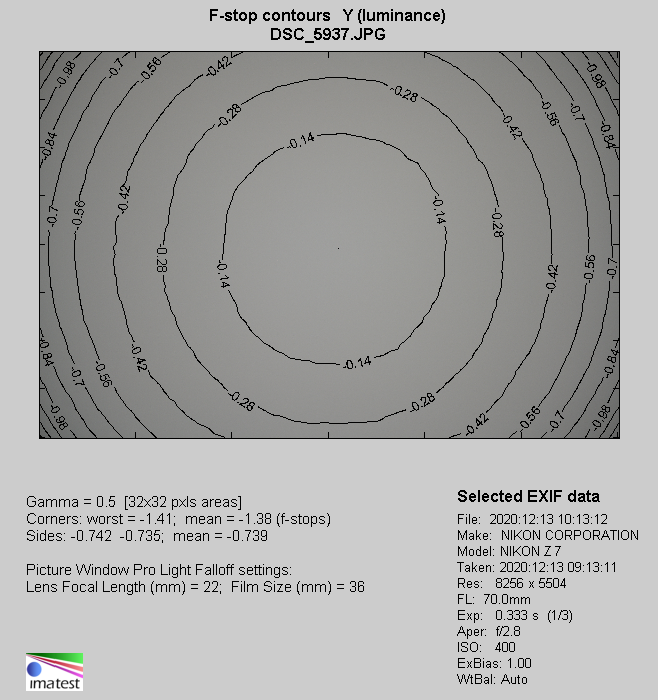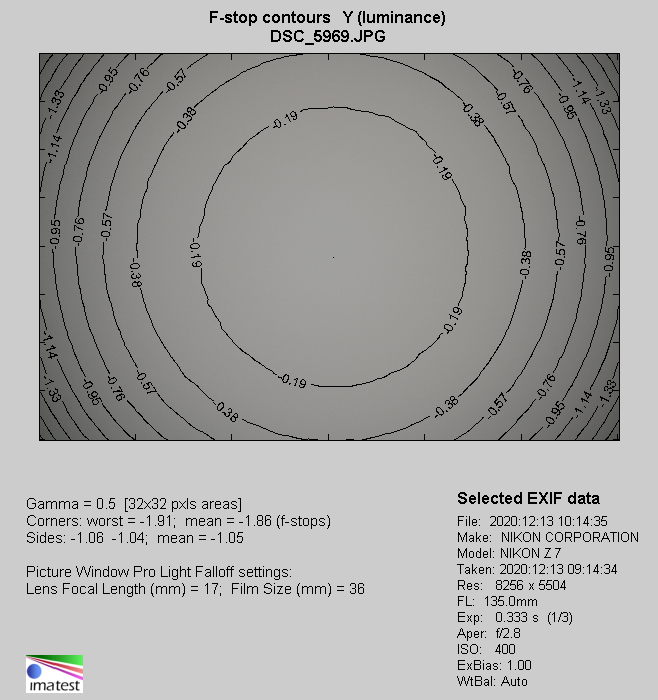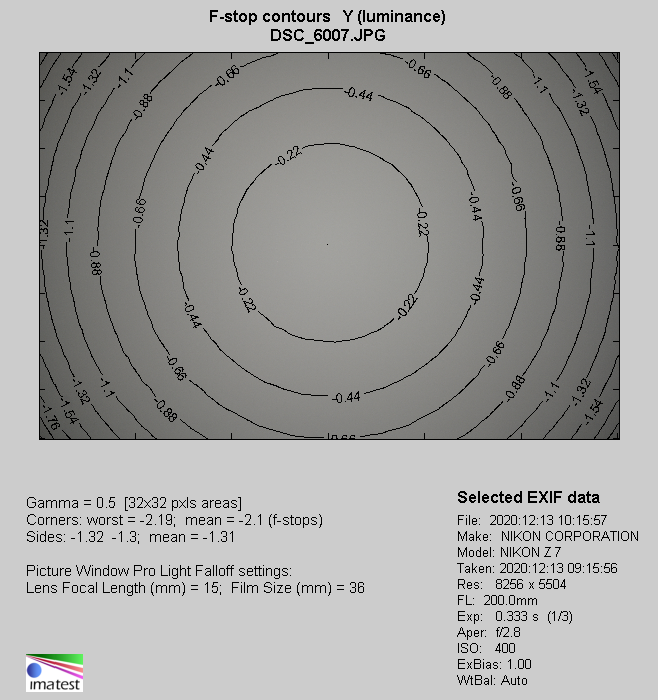Nikon Nikkor Z 70-200 mm f/2.8 VR S
8. Vignetting
| Z7, APS-C, JPEG, 70ámm, f/2.8 | Z7, APS-C, JPEG, 70ámm, f/4.0 |

|

|
| Z7, APS-C, JPEG, 135ámm, f/2.8 | Z7, APS-C, JPEG, 135ámm, f/4.0 |

|

|
| Z7, APS-C, JPEG, 200ámm, f/2.8 | Z7, APS-C, JPEG, 200ámm, f/4.0 |

|

|
In case of the Nikon Z7 body it is possible to switch off vignetting correction and we decided to use that option - accordingly, JPEG files, presented above, are not vignetting-corrected by the camera. When it comes to this lens we also switched off distortion correction so vignetting results on JPEG files are, within the margin of error, the same as on RAW files. It allows us to deal with just one kind of files in our analysis.
Please Support UsIf you enjoy our reviews and articles, and you want us to continue our work please, support our website by donating through PayPal. The funds are going to be used for paying our editorial team, renting servers, and equipping our testing studio; only that way we will be able to continue providing you interesting content for free. |
- - - - - - - - - - - - - - - - - - - - - - - - - - - - - - - - - - - - - - - - - - - - - - - -
In case of the APS-C/DX sensor problems concerning vignetting category are practically non-existent. At 70 mm and by f/2.8 brightness loss in frame corners amounts to just 14% (−0.44 EV), and it decreases to a completely imperceptible value of 2% (−0.06 EV) on stopping down the aperture to f/4.0.
In the middle of the focal range the results are similar: by f/2.8 vignetting amounts to 17% (−0.54 EV), and by f/4.0 it drops once again to a level of just 2% (−0.07 EV).
A slight increase of vignetting levels can be noticed at 200 mm where, at the maximum relative aperture, the aberration reaches 25% (−0.53 EV); fortunately by f/4.0 it drops to an imperceptible level of 7% (−0.22 EV).
Still, only full frame can be considered a real test for the Nikkor lens, examined here. Let's glance at some thumbnails, presented below.
| Z7, FF, JPEG, 70ámm, f/2.8 | Z7, FF, JPEG, 70ámm, f/4.0 |

|

|
| Z7, FF, JPEG, 135ámm, f/2.8 | Z7, FF, JPEG, 135ámm, f/4.0 |

|

|
| Z7, FF, JPEG, 200ámm, f/2.8 | Z7, FF, JPEG, 200ámm, f/4.0 |

|

|
At the 70 mm focal length and the maximum relative aperture light fall-off can be noticed without any problems as it reaches 8% (−1.38 EV). Fortunately that aberration decreases very quickly on stopping down because by f/4.0 it amounts to 19% (−0.63 EV), and by f/5.6 it descends to an imperceptible value of 7% (−0.22 EV).
A bit more problems you see in the middle of the focal range: by f/2.8 brightness loss in the frame corners is 47% (−1.86 EV). That aberration becomes moderate by f/4.0 and we got a result of 25% (−0.88 EV). What's more, by f/5.6 and f/8.0 the problem disappears almost completely with values of 2% (−0.39 EV) and 7% (−0.21 EV) respectively.
The weakest performance can be observed at the 200 mm focal length. If you employ the f/2.8 aperture you have to take into account a loss of 52% (−2.10 EV) of light in frame corners. By f/4.0 the aberration decreases to 31% (−1.06 EV), and by f/5.6 it drops to 17% (−0.54 EV). All vignetting-related problems become marginalized near f/8.0, where you have to deal with just 10% (−0.30 EV) of brightness loss.
To sum up the tested lens doesn't have almost any problems with vignetting on the smaller APS-C/DX sensor. On full frame this aberration is visible but mainly in the proximity of the maximum relative aperture as stopping down is able to limit its influence quite efficiently. In the era of mirrorless cameras vignetting can be a huge problem and results of 3 EV or more are not that rare. Taking it into account the performance of this fast zoom lens should be considered sensibly good.
| Nikon Z7, 70ámm, JPEG, f/2.8 |
 |
| Nikon Z7, 135ámm, JPEG, f/2.8 |
 |
| Nikon Z7, 200ámm, JPEG, f/2.8 |
 |






